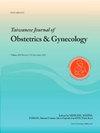在一次妊娠中,羊膜腔穿刺时发现 46,XX,+21,der(21;21)(q10;q10)/46,XX 的罗伯逊不平衡易位导致低水平镶嵌式 21 三体综合征,胎儿结局良好;培养羊膜细胞和未培养羊膜细胞之间存在细胞遗传差异;各种组织之间存在细胞遗传差异;围产期 21 三体综合征细胞系逐渐减少
IF 2
4区 医学
Q2 OBSTETRICS & GYNECOLOGY
引用次数: 0
摘要
病例报告 一位 41 岁的初产妇因高龄而在妊娠 17 周时接受了羊膜腔穿刺术。她的丈夫 41 岁。羊水穿刺显示核型为 46,XX,+21,der(21;21)(q10;q10)[8]/46,XX[18],与 30.8%(8/26 例)的 21 三体嵌合相符。同时对未培养羊膜细胞提取的 DNA 进行阵列比较基因组杂交(aCGH)分析,结果显示为 arr (1-22,X) × 2,无基因组失衡。妊娠 21 周时再次进行羊膜腔穿刺,发现核型为 46,XX,+21,der(21;21)(q10;q10)[2]/46,XX[25],与 7.4%(2/27 个菌落)的 21 三体嵌合情况一致。脐带血取样显示结果为 46,XX 和 rsa X(P095) ×2、13,18,21(P095) ×2。妊娠 23 周时,她接受了脐带血采样,结果显示核型为 46,XX。妊娠 26 周时,她被转介到遗传咨询中心。医生建议她不要再次进行羊水穿刺,并继续妊娠。母亲的核型为 46,XX,父亲的核型为 46,XY。妊娠 38 周时,一个重 3476 克、表型正常的婴儿娩出。脐带血核型为 46,XX,+21,der(21;21)(q10;q10)[1]/46,XX[39](2.5% 嵌合)。胎盘核型为 46,XX,+21,der(21;21)(q10;q10)(40/40 个细胞)。两个月大时进行随访,新生儿的表型和发育均正常。外周血核型为 46,XX(40/40 个细胞),口腔粘膜细胞的 aCGH 分析结果显示没有基因组失衡。结论羊膜腔穿刺术中由于罗伯逊不平衡易位导致的低水平镶嵌式 21 三体综合征与正常细胞系、培养的羊膜细胞与未培养的羊膜细胞之间的细胞遗传差异、各种组织之间的细胞遗传差异以及围生期 21 三体细胞系的逐渐减少有关。本文章由计算机程序翻译,如有差异,请以英文原文为准。
Low-level mosaic trisomy 21 due to mosaic unbalanced Robertsonian translocation of 46,XX,+21,der(21;21) (q10;q10)/46,XX at amniocentesis in a pregnancy associated with a favorable fetal outcome, cytogenetic discrepancy between cultured amniocytes and uncultured amniocytes, cytogenetic discrepancy among various tissues and perinatal progressive decrease of the trisomy 21 cell line
Objective
We present prenatal diagnosis of mosaic trisomy 21 at amniocentesis associated with unbalanced Robertsonian translocation in the fetus and a favorable fetal outcome.
Case Report
A 41-year-old, primigravid woman underwent amniocentesis at 17 weeks of gestation because of advanced maternal age. Her husband was 41 years old. Amniocentesis revealed a karyotype of 46,XX,+21,der(21;21) (q10;q10)[8]/46,XX[18], consistent with 30.8% (8/26 colonies) mosaicism for trisomy 21. Simultaneous array comparative genomic hybridization (aCGH) analysis on the DNA extracted from uncultured amniocytes revealed the result of arr (1–22,X) × 2 with no genomic imbalance. Repeat amniocentesis at 21 weeks of gestation revealed a karyotype of 46,XX,+21,der(21;21) (q10;q10)[2]/46,XX[25], consistent with 7.4% (2/27 colonies) mosaicism for trisomy 21. Cord blood sampling revealed the result of 46,XX and rsa X(P095) × 2, 13,18,21(P095) × 2. Prenatal ultrasound findings were normal. At 23 weeks of gestation, she underwent cord blood sampling which revealed a karyotype of 46,XX. At 26 weeks of gestation, she was referred for genetic counseling. No repeat amniocentesis and continuing the pregnancy were advised. The mother had a karyotype of 46,XX, and the father had a karyotype of 46,XY. At 38 weeks of gestation, a 3476-g, phenotypically normal baby was delivered. The cord blood had a karyotype of 46,XX,+21,der(21;21) (q10;q10)[1]/46,XX[39] (2.5% mosaicism). The placenta had a karyotype of 46,XX,+21,der(21;21) (q10;q10) (40/40 cells). When follow-up at age two months, the neonate was normal in phenotype and development. The peripheral blood had a karyotype of 46,XX (40/40 cells), and aCGH analysis on buccal mucosal cells resulted no genomic imbalance.
Conclusion
Low-level mosaic trisomy 21 at amniocentesis due to mosaic unbalanced Robertsonian translocation with a normal cell line can be associated with a favorable fetal outcome, cytogenetic discrepancy between cultured amniocytes and uncultured amniocytes, cytogenetic discrepancy among various tissues and perinatal progressive decrease of the trisomy 21 cell line.
求助全文
通过发布文献求助,成功后即可免费获取论文全文。
去求助
来源期刊

Taiwanese Journal of Obstetrics & Gynecology
OBSTETRICS & GYNECOLOGY-
CiteScore
3.60
自引率
23.80%
发文量
207
审稿时长
4-8 weeks
期刊介绍:
Taiwanese Journal of Obstetrics and Gynecology is a peer-reviewed journal and open access publishing editorials, reviews, original articles, short communications, case reports, research letters, correspondence and letters to the editor in the field of obstetrics and gynecology.
The aims of the journal are to:
1.Publish cutting-edge, innovative and topical research that addresses screening, diagnosis, management and care in women''s health
2.Deliver evidence-based information
3.Promote the sharing of clinical experience
4.Address women-related health promotion
The journal provides comprehensive coverage of topics in obstetrics & gynecology and women''s health including maternal-fetal medicine, reproductive endocrinology/infertility, and gynecologic oncology. Taiwan Association of Obstetrics and Gynecology.
 求助内容:
求助内容: 应助结果提醒方式:
应助结果提醒方式:


